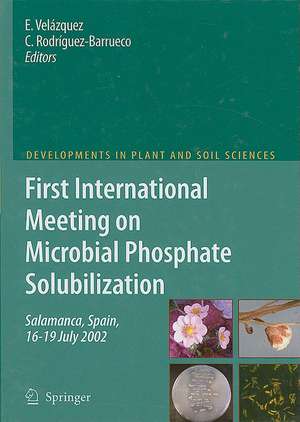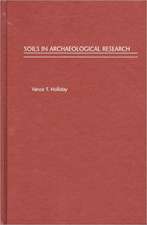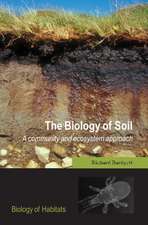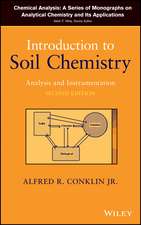First International Meeting on Microbial Phosphate Solubilization: Developments in Plant and Soil Sciences, cartea 102
Editat de E. Velazquez, C. Rodriguez-Barruecoen Limba Engleză Hardback – 2 apr 2007
| Toate formatele și edițiile | Preț | Express |
|---|---|---|
| Paperback (1) | 1232.26 lei 6-8 săpt. | |
| SPRINGER NETHERLANDS – 30 noi 2010 | 1232.26 lei 6-8 săpt. | |
| Hardback (1) | 1073.18 lei 38-44 zile | |
| SPRINGER NETHERLANDS – 2 apr 2007 | 1073.18 lei 38-44 zile |
Din seria Developments in Plant and Soil Sciences
- 18%
 Preț: 1225.94 lei
Preț: 1225.94 lei -
 Preț: 391.79 lei
Preț: 391.79 lei - 18%
 Preț: 1225.94 lei
Preț: 1225.94 lei - 18%
 Preț: 1228.29 lei
Preț: 1228.29 lei - 18%
 Preț: 1246.95 lei
Preț: 1246.95 lei - 18%
 Preț: 970.70 lei
Preț: 970.70 lei - 24%
 Preț: 1073.76 lei
Preț: 1073.76 lei -
 Preț: 396.24 lei
Preț: 396.24 lei -
 Preț: 386.81 lei
Preț: 386.81 lei - 15%
 Preț: 699.93 lei
Preț: 699.93 lei -
 Preț: 384.86 lei
Preț: 384.86 lei - 18%
 Preț: 1221.69 lei
Preț: 1221.69 lei - 18%
 Preț: 1233.06 lei
Preț: 1233.06 lei -
 Preț: 399.12 lei
Preț: 399.12 lei - 18%
 Preț: 1227.67 lei
Preț: 1227.67 lei -
 Preț: 383.93 lei
Preț: 383.93 lei - 18%
 Preț: 1826.85 lei
Preț: 1826.85 lei - 18%
 Preț: 1232.09 lei
Preț: 1232.09 lei - 15%
 Preț: 646.94 lei
Preț: 646.94 lei - 18%
 Preț: 1231.47 lei
Preț: 1231.47 lei - 15%
 Preț: 650.55 lei
Preț: 650.55 lei - 15%
 Preț: 638.24 lei
Preț: 638.24 lei - 18%
 Preț: 955.08 lei
Preț: 955.08 lei -
 Preț: 385.61 lei
Preț: 385.61 lei -
 Preț: 382.36 lei
Preț: 382.36 lei -
 Preț: 407.98 lei
Preț: 407.98 lei -
 Preț: 393.35 lei
Preț: 393.35 lei - 18%
 Preț: 1224.54 lei
Preț: 1224.54 lei - 18%
 Preț: 1222.01 lei
Preț: 1222.01 lei - 18%
 Preț: 1228.15 lei
Preț: 1228.15 lei -
 Preț: 382.95 lei
Preț: 382.95 lei - 18%
 Preț: 1227.84 lei
Preț: 1227.84 lei
Preț: 1073.18 lei
Preț vechi: 1412.08 lei
-24% Nou
Puncte Express: 1610
Preț estimativ în valută:
205.35€ • 215.01$ • 170.33£
205.35€ • 215.01$ • 170.33£
Carte tipărită la comandă
Livrare economică 05-11 aprilie
Preluare comenzi: 021 569.72.76
Specificații
ISBN-13: 9781402040191
ISBN-10: 1402040199
Pagini: 372
Ilustrații: X, 362 p.
Dimensiuni: 193 x 260 x 28 mm
Greutate: 1.04 kg
Ediția:2007
Editura: SPRINGER NETHERLANDS
Colecția Springer
Seria Developments in Plant and Soil Sciences
Locul publicării:Dordrecht, Netherlands
ISBN-10: 1402040199
Pagini: 372
Ilustrații: X, 362 p.
Dimensiuni: 193 x 260 x 28 mm
Greutate: 1.04 kg
Ediția:2007
Editura: SPRINGER NETHERLANDS
Colecția Springer
Seria Developments in Plant and Soil Sciences
Locul publicării:Dordrecht, Netherlands
Public țintă
ResearchCuprins
From the contents
Taxonomy of rhizobia: An Overview: A. Willems; Genetics of phosphate solubilization and its potential application for improving plant growth-promoting bacteria: H. Rodríguez, R. Fraga, T. Gonzalez and Y. Bashan; Biodiversity of populations of phosphate solubilizing rhizobia that nodulates chickpea in different Spanish soils: R. Rivas, A. Peix, P. F. Mateos, M.E. Trujillo, E. Martínez-Molina and E. Velásquez; Phosphate solubilization activity of rhizobia native to Iranian soils: H. A. Alikhani, N. Saleh-Rastin and H. Antoun; Differential effects of coinoculations with Pseudomonas jessenii PS06 (a phosphate-solubilizing bacterium) and Mesorhizobium ciceri C-2/2 strains on the growth and seed yield of chickpea under greenhouse and field conditions: A. Valverde, A. Burgos, T. Fiscella, R. Rivas, E. Velázquez, C. Rodríguez-Barrueco, E. Cervantes, M. Chamber and J. M. Igual; Effect of Tilemsi phosphate rock solubilizing microorganisms on phosphorus-uptake and yield of field grown wheat in Mali: B. A. Hamadoun and H. Antoun; Screening for PGPR to improve growth of Cistus ladanifer seedlings for reforestation of degraded mediterranean ecosystems: B. Ramos, T. Pereyra de la Iglesia, A. Probanza, J.A. Lucas García, M. Mejías and F.J.Gutierrez Mañero; Phosphate-solubilizing microorganisms isolated from rhizospheric and bulk soils of colonizer plants at an abandoned rock phosphate mine: I. Reyes, A. Valery and Z. Valduz; Microbial solubilization of rock phosphate on media containing agro-industrial wastes and effect of the resulting products on plant growth and P uptake; N. Vassilev, M. Vassileva, A. Medina and R. Azcón; Making microorganisms mobilize soil phosphorous: A. Richardson; Future trends in research on microbial phosphate solubilization: one hundred years of insolubility: A. H. Goldstein; Molecular methods for biodiversity analysis of phosphate solubilizing bacteria (PSB): A.Peix , E. Velázquez and E. Martínez-Molina; Taxonomyof phosphate solubilizing bacteria: P. Kämpfer; Taxonomy of filamentous fungi and yeasts that solubilizes phosphate: E. Velázquez and M. E. Trujillo; Phosphate solubilizing microorganisms: effect of Carbon, Nitrogen, and Phosphorus sources: E. Nahas; Efficacy of organic acid secreting bacteria in solubilization of rock phosphate in acidic alfisols: S. Srivastava, M. T. Kausalya, G. Archana, O. P. Rupela and G. Naresh-Kumar; Solubilization of iron and aluminum phosphates in the soil by the fungus Aspergillus niger: C. B. Barroso and E. Nahas; Fertilizers, food and environment: J. M. Igual and C. Rodríguez-Barrueco; Phosphate Solubilizing Microorganisms vs. Phosphate Mobilizing Microorganisms: What separates a phenotype from a trait?: A. H. Goldstein and P.U. Krishnaraj; Challenges in commercializing a phosphate solubilizing microorganism: Penicillium bilaiae, a case history: M. Leggett, J. Cross, G. Hnatowich, and G. Holloway; Interactive effects of phosphate-solubilizing bacteria and mycorrhizal fungi at increasing plant P availability and their evaluation by using isotopic techniques: J. M. Barea, M. Toro and R. Azcón; Distribution pattern and role of phosphate solubilizing bacteria in the enhancement of fertilizer value of rock phosphate in aquaculture ponds: state of the art: B.B. Jana; Construction of a vector for stable chromosomal integration of the phoc gene in plant growth- promoting bacteria: R. Fraga-Vidal, H. Rodríguez Mesa and T. González -Díaz de Villegas; Microorganisms with capacity for phosphate solubilization in Dão red wine (Portugal): L. R. Silva, R. Rivas, A. M. Pinto, P. F. Mateos, E. Martínez-Molina and E. Velásquez.
Taxonomy of rhizobia: An Overview: A. Willems; Genetics of phosphate solubilization and its potential application for improving plant growth-promoting bacteria: H. Rodríguez, R. Fraga, T. Gonzalez and Y. Bashan; Biodiversity of populations of phosphate solubilizing rhizobia that nodulates chickpea in different Spanish soils: R. Rivas, A. Peix, P. F. Mateos, M.E. Trujillo, E. Martínez-Molina and E. Velásquez; Phosphate solubilization activity of rhizobia native to Iranian soils: H. A. Alikhani, N. Saleh-Rastin and H. Antoun; Differential effects of coinoculations with Pseudomonas jessenii PS06 (a phosphate-solubilizing bacterium) and Mesorhizobium ciceri C-2/2 strains on the growth and seed yield of chickpea under greenhouse and field conditions: A. Valverde, A. Burgos, T. Fiscella, R. Rivas, E. Velázquez, C. Rodríguez-Barrueco, E. Cervantes, M. Chamber and J. M. Igual; Effect of Tilemsi phosphate rock solubilizing microorganisms on phosphorus-uptake and yield of field grown wheat in Mali: B. A. Hamadoun and H. Antoun; Screening for PGPR to improve growth of Cistus ladanifer seedlings for reforestation of degraded mediterranean ecosystems: B. Ramos, T. Pereyra de la Iglesia, A. Probanza, J.A. Lucas García, M. Mejías and F.J.Gutierrez Mañero; Phosphate-solubilizing microorganisms isolated from rhizospheric and bulk soils of colonizer plants at an abandoned rock phosphate mine: I. Reyes, A. Valery and Z. Valduz; Microbial solubilization of rock phosphate on media containing agro-industrial wastes and effect of the resulting products on plant growth and P uptake; N. Vassilev, M. Vassileva, A. Medina and R. Azcón; Making microorganisms mobilize soil phosphorous: A. Richardson; Future trends in research on microbial phosphate solubilization: one hundred years of insolubility: A. H. Goldstein; Molecular methods for biodiversity analysis of phosphate solubilizing bacteria (PSB): A.Peix , E. Velázquez and E. Martínez-Molina; Taxonomyof phosphate solubilizing bacteria: P. Kämpfer; Taxonomy of filamentous fungi and yeasts that solubilizes phosphate: E. Velázquez and M. E. Trujillo; Phosphate solubilizing microorganisms: effect of Carbon, Nitrogen, and Phosphorus sources: E. Nahas; Efficacy of organic acid secreting bacteria in solubilization of rock phosphate in acidic alfisols: S. Srivastava, M. T. Kausalya, G. Archana, O. P. Rupela and G. Naresh-Kumar; Solubilization of iron and aluminum phosphates in the soil by the fungus Aspergillus niger: C. B. Barroso and E. Nahas; Fertilizers, food and environment: J. M. Igual and C. Rodríguez-Barrueco; Phosphate Solubilizing Microorganisms vs. Phosphate Mobilizing Microorganisms: What separates a phenotype from a trait?: A. H. Goldstein and P.U. Krishnaraj; Challenges in commercializing a phosphate solubilizing microorganism: Penicillium bilaiae, a case history: M. Leggett, J. Cross, G. Hnatowich, and G. Holloway; Interactive effects of phosphate-solubilizing bacteria and mycorrhizal fungi at increasing plant P availability and their evaluation by using isotopic techniques: J. M. Barea, M. Toro and R. Azcón; Distribution pattern and role of phosphate solubilizing bacteria in the enhancement of fertilizer value of rock phosphate in aquaculture ponds: state of the art: B.B. Jana; Construction of a vector for stable chromosomal integration of the phoc gene in plant growth- promoting bacteria: R. Fraga-Vidal, H. Rodríguez Mesa and T. González -Díaz de Villegas; Microorganisms with capacity for phosphate solubilization in Dão red wine (Portugal): L. R. Silva, R. Rivas, A. M. Pinto, P. F. Mateos, E. Martínez-Molina and E. Velásquez.
Textul de pe ultima copertă
Last decade has seen a significantly increased knowledge about phosphate solubilizing microorganisms. Sixty specialists from thirteen countries met in Salamanca to discuss the problems of the high P-unavailability as a soil nutrient for crops, and the hazards of an increasing phosphate input to aquatic habitats from industrial and mining activities, sewage disposal, detergents, and other sources. Updated solutions to enhance P-uptake by plants, bioremediation potential in the rehabilitation of ecosystems, taxonomic characterization interactions with mycorrizae, the physiological and molecular basis of PSM, and possibilities of genetic modifications of rhizospheric microorganisms were among the contributions presented. Challenges in commercializing a phosphate solubilizing microorganism were also outlined by a relevant biotech company. The book will fill a gap in agricultural libraries and it is a wish of the editors to attract the attention of agronomists, environmentalist, technocrats and administrators holding responsibilities in the field of soil conservation and sustainable agricultural production.
Caracteristici
Shows basic and strategic research related to: taxonomy and diversity of PSM with an emphasis in the rhizobia and in interactions between phosphate solubilizing bacteria and mycorrizae Physiology and molecular basis of microbial phosphate solubilization PSM as biofertilizers and their use in bioremediation













